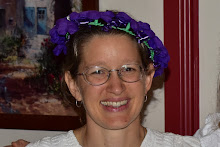Today, I got going nice and early, because I wanted to go to the Titmouse Club, which started at 10am. So about 9:20, we started doing Bible and calendar, and finished in plenty of time to get there. The club meets in a nature sanctuary, and I wasn't sure exactly which wooded path would lead me to the right location, but I happened to guess right and we were among the first ones there. It's ostensibly for children ages 2 1/2 to 5, which is perfect for my two, though it seemed that P was the oldest one there.
The club started out with a "lesson", in this case a discussion of the history of this particular nature sanctuary (complete with a story of how the founder had, during a flood, taken refuge on the roof of her cabin, saw a wild pig floating by, rescued it, and after the flood made it her pet). The docent read 2 books to the group, and then they did a craft. The children were each given a 2-foot square of muslin and some leaves, which they painted and pressed on the muslin. The effect was somewhat different when the adult demonstrated and when the children imitated, but the resulting works of art were at least interesting, and we used them as tablecloths for dinner this evening. After the craft, the kids played "nature walk bingo". Each child was given a clipboard with a set of 25 pictures, and if they made a row of 4 or more, they won a prize. This was actually easier than I thought at first, and the kids saw (among other things) a spider web, a mushroom, a turtle, a school of mosquito fish (hooray for mosquito fish! Long may they prosper, and eat, and eat, and eat...), raccoon tracks, and poison ivy. At the end of the game, each child got a prize.
After Titmouse Club, we returned home and did the language arts lesson for the day. P happily completed her handwriting worksheet this time. Her other assignment was to look at an interesting picture (this one contained a boy and a robot sitting on a step, clearly deeply in conversation) and tell a story. P's story went something like this: "A robot travelled to earth from another planet to explore it. When he was exploring he found a boy. The robot and the boy started talking about the interesting places the robot saw. They were trying to decide which places the robot should take the boy." I asked P which 3 places she would ask the robot to take her, if she were to be in the boy's situation. She thought she'd like to see the Grand Canyon, sharks in the Indian Ocean, and she'd like to dig in the ground to find beautiful rocks.
E wasn't restless during P's story, and it seemed that he really enjoyed listening to her. However, he was quite happy to do his own "school" (the puzzles again). This time we looked at each side of each puzzle after he had assembled it, and discussed what was on each side and what the pictures looked like when we put the pieces together. P kept playing with the remaining pieces while E and I were discussing the puzzle he'd most recently assembled, and I had to ask her several times to leave E's school alone, since we wanted him to leave hers alone.
After lunch, we had fun with red cabbage. If you cook red cabbage in water, the resulting cabbage water is a delightful pH indicator. Vinegar turns it from purple to bright red; baking soda turns it greenish blue. This was fun to play with for a while, and of course the obvious next step, that of adding baking soda to vinegar, is entertaining as well. At the end, we added water from the fish tank to the remaining cabbage water, and it turned slightly bluish. Since guppies like water with a pH of around 8.5, this shows that our guppies have happy water. (I didn't explain the pH scale, though I did mention the terms "acid" and "base"). The cabbage water was much more popular with the kids than the red cabbage dish we ate for dinner, but at least the adults enjoyed it.
Subscribe to:
Post Comments (Atom)


No comments:
Post a Comment